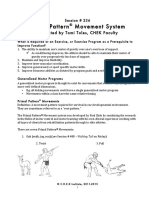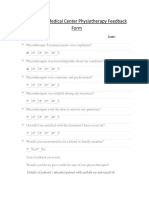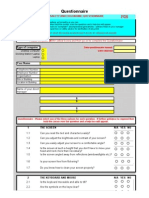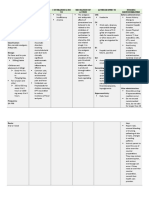0 ratings0% found this document useful (0 votes)
611 viewsExercise Program Design For Special Population
This document discusses exercise program design for special populations. It defines special populations as those with cardiovascular, pulmonary, metabolic, immunological, musculoskeletal, neuromuscular, cancer, or psychological conditions. The key factors in determining an exercise program are the FITT principle, SAID principle, overload principle, and the patient's physical activity stage and health status. Programs should begin low intensity and progress gradually. Communication with the patient's healthcare provider is important. Hindrances can include a lack of teamwork or planning and relying on only one treatment approach. Evidence-based practice and past experience should guide program design tailored to the individual patient.
Uploaded by
kitu_alagappan4720Copyright
© © All Rights Reserved
We take content rights seriously. If you suspect this is your content, claim it here.
Available Formats
Download as PPTX, PDF, TXT or read online on Scribd
0 ratings0% found this document useful (0 votes)
611 viewsExercise Program Design For Special Population
This document discusses exercise program design for special populations. It defines special populations as those with cardiovascular, pulmonary, metabolic, immunological, musculoskeletal, neuromuscular, cancer, or psychological conditions. The key factors in determining an exercise program are the FITT principle, SAID principle, overload principle, and the patient's physical activity stage and health status. Programs should begin low intensity and progress gradually. Communication with the patient's healthcare provider is important. Hindrances can include a lack of teamwork or planning and relying on only one treatment approach. Evidence-based practice and past experience should guide program design tailored to the individual patient.
Uploaded by
kitu_alagappan4720Copyright
© © All Rights Reserved
We take content rights seriously. If you suspect this is your content, claim it here.
Available Formats
Download as PPTX, PDF, TXT or read online on Scribd
You are on page 1/ 9
Exercise program
design for special
population
ALAGAPPAN THIYAGARAJAN
ORTHOPAEDIC AND SPORTS PHYSIOTHERAPIST
Who are special population?
Cardiovascular – Myocardial infarction, angina, peripheral vascular disease, congestive heart
failure, revascularization, heart valve disorders, and/or conduction disorders.
Pulmonary – Chronic obstructive pulmonary disorder, chronic restrictive pulmonary disorder,
pulmonary hypertension, and/or asthma.
Metabolic – Diabetes (Type I and II), overweight/obesity, pre-diabetes, metabolic syndrome,
thyroid disorders, and/or end-stage renal disease.
Immunological – AIDS/HIV, fibromyalgia, chronic fatigue syndrome, anaemia, autoimmune
disorders (e.g., lupus, rheumatoid arthritis), and/or blood clotting disorders.
Musculoskeletal – Osteoporosis, limb amputations, osteoarthritis, lower back conditions, frailty,
joint disorders, joint replacements, sarcopenia, posture disorders, and cystic fibrosis.
Neuromuscular – Stroke, brain injury, spinal cord disorders, multiple sclerosis, cerebral palsy,
Down’s syndrome, Parkinson’s disease, epilepsy, balance disorders, and muscular dystrophy.
Cancer – Multiple body systems affected.
Psychological/behavioral – Disordered eating, body image disorders, depression, and chemical
dependency. Special populations also include those groups of people with unique traits that are not
necessarily afflicted by a chronic or temporary health condition.
Females that are pregnant, postpartum and menopausal.
Older adults.
Children and adolescents with specific exercise prescription needs
What determines exercise program
design
24 years old male with no co morbid, has problem on l5-s1 disc
pathology, whats your exercise program design ?
74 years old female with recently diagnosed parkinsonism, has
history of DM,HT,Heart disease, what your home care exercise plan?
A 6 years old female, has diagnosed with costochondirtis whats your
program design?
A 24 years old football athlete with post acl reconstruction with 6
weeks old wants to do skill specific program, whats your plan?
60 years old sedentary male admitted in hospital followed by post
hernia repair, the general consultant refers chest physiotherapy
what's your treatment plan?
Theory behind exercise prescription
FITT (frequency,intensity,type,time)principle
SAID("Specific Adaptation to Imposed Demands.“) principle
Overload ,specificity, Adaptation,Recovery,Reversibility, indiduvality
principle(sports practice)
Look for where you patient physical activity stages of Precontemplation,
contemplation, Preparation,action, Maintenance
The Five-A's Model to Facilitate Behavioural Changes of Patients in the
Context of Promoting Physical
Activity.(assess,advice,agree,assist,advice)
Consider implementing health and skill related fitness on your
prescription
Use theories like learning, and periodization on to your prescription
Depend on varieties of protocol, get knowledge with patient set point
For patients who need special
considerations, keep the following in
mind:
The program should begin with low-to-moderate intensity and then
progress gradually.
The nature of the program depends on the current health status and
physical condition of the client, as well as any other factors identified in
the interviewing or screening process.
To cater to the needs of clients with chronic illnesses or who require
special considerations, be sure to acquire the necessary education and
skills.
Maintain close communication with the patients primary healthcare
provider, as well as obtain and adhere to his or her recommendations
and guidelines for programming.
When providing information to a patients healthcare provider, utilize
SOAP notes for documentation of client encounters, health status, and
progress.
Plan according to patient needs, always work on progression
Hindrance to our plans of
prescription
The team work in clinical set up
Other related professionals(eg- yoga, fitness guru, new varieties of
training)
Lack of planning by the physiotherapist
Patients who feel always they are right ,therapist is wrong
Passive bound therapy application (pain management)
Sticking to one monotonous protocol and the owner and his team
mates
Relaying on new techniques both on active and passive application
What evidence says
There are lot of documents related to your patients requrirement
Depend on books
Implement your past experiences
Seek for evidence
Follow the patient requirement with a tailored made protocol
Recommended readings
Paul chek program design
American council on exercise- medical exercise specialist /health
fitness
Thank you
You might also like
- NSCA Exam Preparation Strategies With Flowchart For The Certified Personal Trainer CPT Exam (NSCA 2008)100% (1)NSCA Exam Preparation Strategies With Flowchart For The Certified Personal Trainer CPT Exam (NSCA 2008)21 pages
- Klatt Test Assesment Tool For Lower BodyNo ratings yetKlatt Test Assesment Tool For Lower Body6 pages
- SOP - Concierge Bell Desk - Guest Luggage Handling Procedure100% (2)SOP - Concierge Bell Desk - Guest Luggage Handling Procedure2 pages
- By - Gary Gray, PT - Gray Institute (PDFDrive)100% (1)By - Gary Gray, PT - Gray Institute (PDFDrive)16 pages
- 7 Primal Movement Patterns: All Rights Reserved100% (2)7 Primal Movement Patterns: All Rights Reserved31 pages
- Integrated Core Training Manual - LowRes PDF100% (3)Integrated Core Training Manual - LowRes PDF48 pages
- Primal Pattern Diet Questionnaire 2nd EditionNo ratings yetPrimal Pattern Diet Questionnaire 2nd Edition6 pages
- Essentials of Coaching & Training Functional Continuums: Gray Cook Lee Burton Dan JohnNo ratings yetEssentials of Coaching & Training Functional Continuums: Gray Cook Lee Burton Dan John38 pages
- Movement Primer: Fundamentals of Movement Mechanics to Improve Health, Strength and Training PerformanceFrom EverandMovement Primer: Fundamentals of Movement Mechanics to Improve Health, Strength and Training Performance3/5 (1)
- Mike Reinold Shoulder Clinical Exam Checklist100% (1)Mike Reinold Shoulder Clinical Exam Checklist20 pages
- High Performance Sport Skill Instruction, Training, and Coaching. 9 Powerful Principles for Athletes to Flow and Get in the ZoneFrom EverandHigh Performance Sport Skill Instruction, Training, and Coaching. 9 Powerful Principles for Athletes to Flow and Get in the ZoneNo ratings yet
- Goals and Strategies of Stabilization Training: Phase 1: Corrective Exercise Training100% (1)Goals and Strategies of Stabilization Training: Phase 1: Corrective Exercise Training15 pages
- Purpose Driven Movement: The Ultimate Guide to Functional TrainingFrom EverandPurpose Driven Movement: The Ultimate Guide to Functional TrainingNo ratings yet
- Strong Bodies, Strong Business: A Step-By-Step Guide to Building a Sustainable Business Through WeightliftingFrom EverandStrong Bodies, Strong Business: A Step-By-Step Guide to Building a Sustainable Business Through WeightliftingNo ratings yet
- Book 3: Fitness Analysis for Sport: Academy of Excellence for Coaching of Fitness DrillsFrom EverandBook 3: Fitness Analysis for Sport: Academy of Excellence for Coaching of Fitness DrillsNo ratings yet
- Directorate of Distance Education: Tamil Nadu Physical Education and Sports UniversityNo ratings yetDirectorate of Distance Education: Tamil Nadu Physical Education and Sports University4 pages
- First Step Physiotherapy Clinic and Research Institute: Workstation QuestionnaireNo ratings yetFirst Step Physiotherapy Clinic and Research Institute: Workstation Questionnaire2 pages
- PYKKA As Well As For Common Wealth Games-2010No ratings yetPYKKA As Well As For Common Wealth Games-201011 pages
- Risk Assessment Determining Control: Prosedur Hazard Identification, (Hiradc)100% (1)Risk Assessment Determining Control: Prosedur Hazard Identification, (Hiradc)4 pages
- Curriculum- Integrated Course in Hair Skin and Make Up (1)No ratings yetCurriculum- Integrated Course in Hair Skin and Make Up (1)39 pages
- Cbse Class VI Science: General InstructionsNo ratings yetCbse Class VI Science: General Instructions7 pages
- Statistics and Epidemiology Courses StudiedNo ratings yetStatistics and Epidemiology Courses Studied2 pages
- 2012 - Phillips-Temro - Cold Weather Starting Products - LIT0350012 - 2012 - 95 PagesNo ratings yet2012 - Phillips-Temro - Cold Weather Starting Products - LIT0350012 - 2012 - 95 Pages95 pages
- Series 72 Modutrol IV™ Motors: FeaturesNo ratings yetSeries 72 Modutrol IV™ Motors: Features12 pages
- Strategies To Work With Students With Oppositional Defiant PDF100% (3)Strategies To Work With Students With Oppositional Defiant PDF2 pages






































































































